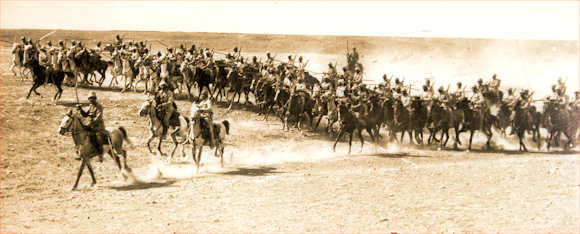 |
| Ottoman Cavalry |
Books in the English language presenting the Ottoman Empire’s side of World War I, whether covering campaigns, strategy, or units, are few and far between. Thankfully, Edward J. Erickson has made an impact in that gap. Erickson, a retired U.S. Army officer and retired professor of history at the U.S. Marine Corps University, has several books focusing on the Ottoman contribution to World War I to his credit. Palestine: The Ottoman Campaigns of 1914-1918 is intended to be a companion volume to Gallipoli: The Ottoman Campaign (Pen & Sword, 2010). Erickson relies heavily on official records (both British and Turkish), as well as a fine array of other primary and secondary sources, to tell this story. His familiarity with, and deep use of Turkish sources makes this a valuable addition to the history of World War I.
In his introduction, Erickson does a wonderful job of describing the distinctions of the Palestinian theater. There were no continuous lines of trenches; actions were characterized by maneuver; battles were of a comparative shorter duration; and campaign rhythm tended to follow the availability (or lack thereof) of supplies. Erickson also argues that, with the absence of mass armies, the part of the individual tended to hold more sway.
 |
| Ottoman Infantry |
Along those lines, Erickson states: “It was at the tactical level in Palestine where it may be argued that Ottoman and German commanders provided brilliant leadership” (p. 6). This is largely supported by subsequent chapters, but the author credits Turkish field army commander Mustafa Kemal with “the finest demonstration of battlefield leadership and tactical skill” (p. 7).
Next Erickson covers the campaigns chronologically and geographically within the Palestinian theater. He thoroughly discusses the organization of Ottoman forces, coupled with changes in command, movement into and out of the theater of various units, and logistical challenges. Each chapter is a nice blend of operational and tactical history, together with a good explanation of strategic background. Erickson describes the ebb and flow of combat and movement in the theater.
 |
| Ottoman Artillery |
By 1917, British General Sir Edmund Allenby proved to be “a master of the operational environment” (p. 124). This, coupled with Ottoman supply difficulties, sealed the Turkish Palestinian army’s fate. Despite the battlefield losses, “it must be remembered that the Ottoman Army was still in the field and actively preparing its defense of the Anatolian heartland when the armistice was signed” (p. 179). In his final chapter, Erickson discusses Ottoman logistics, really an overview of the topic from the previous chapters, and shows the challenges they had to face.
Two appendices give detailed orders of battle for the Ottoman Army in Palestine. The eleven maps in the book are adequate, but, coming from official Turkish sources and written in Turkish, are a bit cumbersome to use. The author and editors would have been better served to use one or two Turkish maps but render the rest in clearer English. Thirty photographs enhance the text and give us a view of the men, terrain, and equipment involved in the campaigns. This book is an important addition to the historiography of World War I. It is highly recommended to anyone interested in the Middle East theater of operations, especially to those who want to read about the Ottoman perspective.
Peter L. Belmonte

This sounds excellent. Especially with the immersion in Turkish sources.
ReplyDelete